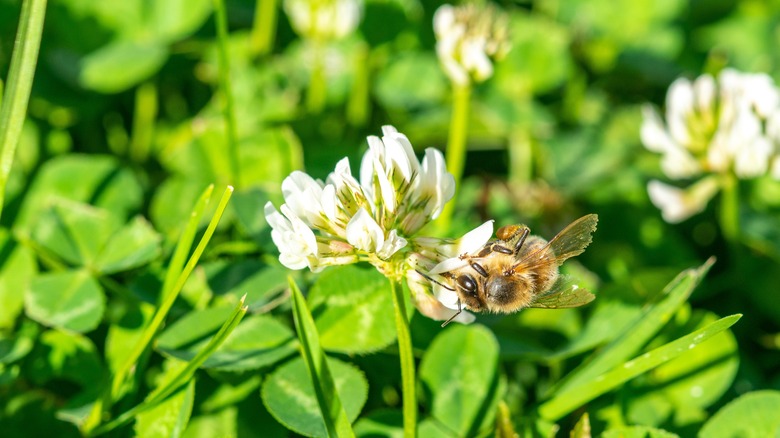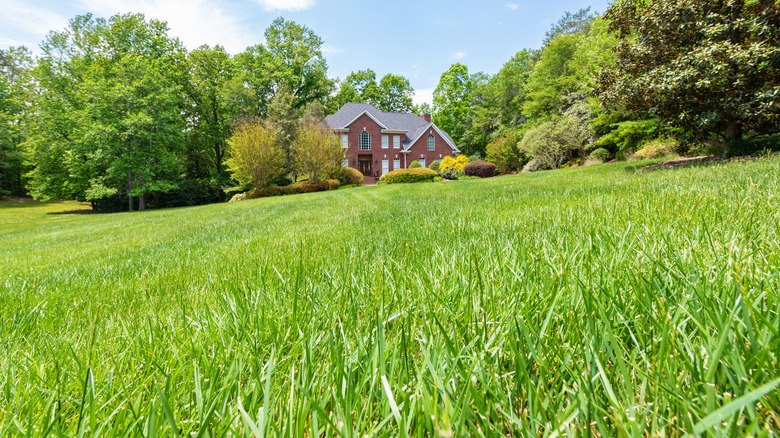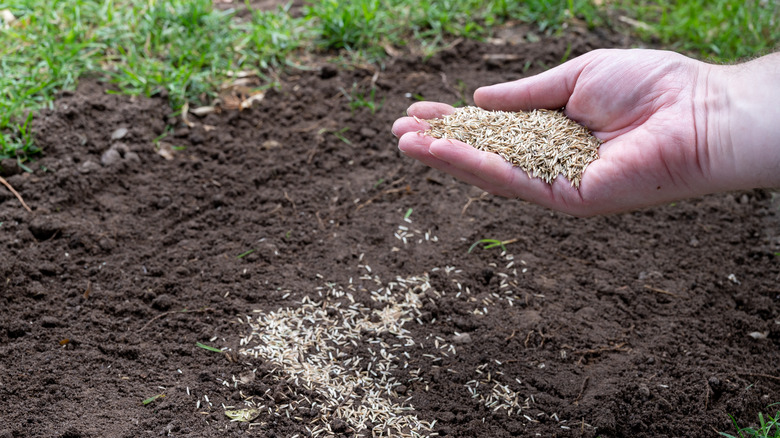The Best Kind Of Grass Seed Mix For A Bee-Friendly Lawn & Garden
Planting pollinator-friendly plants is touted as one of the best ways to bring more pollinators into your yard and garden, but it turns out that's not the only way to do so. Starting a bee-friendly lawn is just as effective a method. As it turns out, fine fescue grass seed mix is the best to use for this task. A bee lawn is an area of mixed grasses and low-growing perennials, in your yard, that functions as a traditional lawn, but also supplies nutrients for pollinating insects. On top of that, this type of lawn is even more environmentally friendly because, once established, watering isn't required except during drought conditions. If you live in a dry climate, in particular, you should consider a bee lawn.
The bee lawn is made of short and tall flowers mixed with grass. Some short flowers that work well in a bee lawn are white clover, creeping thyme, and self-heal. Tall flowers include prairie groundsel, lanceleaf coreopsis, and calico aster. Grasses that can be used include fine fescues and Kentucky bluegrass, though fine fescue comes out on top because it is lower maintenance. With its positive environmental impact and need for little upkeep, making a bee lawn with fine fescue is a no-brainer.
The benefits of seeding with fine fescue grass
When it comes to choosing the proper grass seed for your bee-friendly lawn, you can't go wrong with choosing a fine fescue grass seed mix. The low maintenance grass offers a number of benefits not only to the bee lawn enthusiast, but also to the pollinators themselves. Fine fescue grass is a type of turf grass typically made up of five different species: strong creeping red fescue, slender creeping red fescue, Chewings fescue, hard fescue, and sheep fescue. The fine blades of this type of grass are the perfect foundation for the flowers of your bee lawn because they increase the flowers' chances of establishing themselves within the lawn, making fine fescue a compatible match for the pollinator-friendly flowers.
In terms of maintenance, fine fescues are longer rooted and slower growing, which means they need very little watering and infrequent mowing. Fine fescue also requires no fertilization, irrigation, or weed control. Growing a bee lawn doesn't get any simpler than that!
How to create and seed your own bee lawn mix with fine fescue
Thanks to the growing popularity of bee lawns, pre-mixed seed blends are easy to find at your local garden center, but you can also make your own that incorporates fine fescue. Typically, a seed mix contains adequate ratios of fine fescue with white clover, self-heal, and creeping thyme. This ratio is what you'll want to replicate when making your own seed mix.
For 1,000 square feet of soil, expect the seeding rate to be 4 pounds of fine fescue, 1.1 ounces of dutch white clover, 0.16 ounces of creeping thyme, and 1.2 ounces of self-heal. Planting grass seed is easier with the help of a push broom, so keep one nearby to lighten the load. To achieve the best results, seed your bee lawn in late fall, when plants are going dormant. This prevents the seeds from germinating right away. One benefit of seeding during dormancy is that you won't need to water or fertilize the growing area with the rainier season underway. Then, come spring, the seeds will sprout before weeds out-compete them, leaving your bee lawn even better off.


